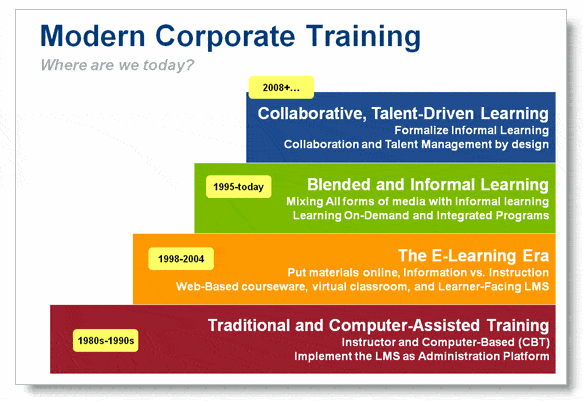January 20, 2017
10 Min. Read

With 77% of U.S. businesses currently offering on-line corporate coaching applications, eLearning is quickly becoming a vital tool for employee training and company performance optimization.
The amount of eLearning technology has almost doubled in the last five years, enabling corporate businesses across the world to tailor their training programs to fit specific company goals, as well as employee profiles.
Here are several essential ways that eLearning technology might help your company to significantly increase the potency of its corporate employee training programs.
Align learning and development to business goals.
The most distinguishing and beneficial aspects of eLearning is that it allows a high degree of customization, allowing supervisors to align online employee training and development programs with the organization business goals.
Efficient execution of eLearning possibilities results in staff equipped with the specific abilities needed to most effectively bring the company closer to its goals.
Offers continuous development opportunities.
Not only does eLearning improve the loyalty of existing workers, it also helps businesses with additional staff recruiting. eLearning equips workers with knowledge that’s internationally important, and, often, universally appropriate.
When choosing an eLearning company, select one that offers training packages combining necessary instruction with individual growth.
Any staff member receiving specialized online training will instantly become strongly connected to the company’s bottom line, leading to an engaging long term commitment.
Reach a global workforce or audience.
eLearning is extremely important to a rapidly globalizing society that is unable to allow enough time for conventional learning methods. While traditional employee coaching has been connected with time away from actual work, as well as expensive trainer and paperwork costs, eLearning methods may be easily incorporated into the busy schedules of both businesses and their staff.
The existence of a plethora of different eLearning companies proves that executives now have an incredibly wide range of possibilities in regard to selecting the best training curriculum for their employees.
While traditional staff training frequently required one to employ a local trainer, eLearning allows the use of tools, such as international video conferencing.
Tracking employee training is easier.
When shooting for ISO 9001 accreditation, consider using employee training tracking software. Auditors look for a well-planned system, and applications, like Schoox, show the need for training. Simply purchasing employee training monitoring applications doesn’t mean you are automatically ISO 9001 accredited.
You should implement the application, plan the training and, from then on, conduct the said training for the workers. Among the biggest challenges when an organization executes a training program is ensuring that the training really happens and is completed in a timely manner.
Lots of businesses lack the tools to track who obtains what training, and who needs training.
For most firms, there is no document that explains either the sequence of training or the real coaching process. Companies that lack employee training tracking applications, such as Schoox, to monitor training and impose training programs, are a lot slower to implement development initiatives and cost cutting activities.
Track training with Schoox.
With Schoox, you can easily pull up all the training by any particular operator and next judge if he/she is qualified to work that process. Or, you can choose a specific training course and see who continues to be taught a particular procedure, equipment knowledge, spec or anything else your business deems as an essential training class.
With Schoox, you may create an unlimited number of training programs. You then assign these training programs to any employee. This employee training monitoring application instantly creates the schedule for every course for every selected employee.
Management creates the precise training plans and Schoox produces a record that details the teaching schedule. For every skill educated per the training plan, the trainer creates training records that are then entered into Schoox software.
The software instantly syncs the training record to the teaching schedule. With Schoox software to maintain all training records in one central location, management can readily review the training obtained and the training due for any worker or course.
With this employee training monitoring software, you can track specific training information, such as class details, course writers, course approvals and important documents. If a worker leaves the company, you may maintain their training on file, but quickly remove them from the list of active employees.
Business Training Software
When it’s time to employ an IT consultant, it isn’t always easy to know just what standards to utilize in order to select the best applicant for the job. If you aren’t familiar or comfortable with the technical side of one’s company, it may make the process even more difficult.
Here are several items to consider to help direct you toward an effective search. An IT consultant with a wide range of product experience and knowledge will save you time and money in the long term. Choose an IT consulting company that offers expertise in systems integration.
The more application apps your company uses, the greater the possible risk of downtime due to system struggles. Each software upgrade, equipment inclusion or new application that’s installed on your system must operate easily with other parts of the system.
When well-informed IT personnel perform these jobs, it means the difference between the high cost of unforeseen downtime or productive workers.
The IT consulting company you choose should offer scalable services. No matter what the size of one’s company is right now, it’s an excellent wager that its IT needs will grow in the future as technical systems become more advanced and complicated.
The company you choose must have the aptitude to handle not only your present needs, but also your future needs, saving yourself the pricey and time intensive job of looking for and hiring new IT advisors on a daily basis.
Your workplace or business might not be officially open twenty-four hours a day and seven days a week.
Enterprise Training
Allowing everyone to create content is a unique idea in most L&D environments. Making content development public gives everybody the opportunity to not only create, but also to edit and comment, on other content.
Even more importantly, you are now providing content easily and quickly to people who need it.
Open the doors of development and begin to scale your business value. It’s the determination to continue to learn and participate in those favorable actions that add value to the business.
An incredibly decorated profile, that shows legitimate accomplishments related to the company, motivates others.
A path easily defines not only what’s possible and accessible to the newest employee, but also how the employee may arrive there. Defining career paths is something L&D cannot do in a vacuum.
Career achievement paths need to be a team effort among L&D, HR and the business units. You’ll want an enterprise learning management system which will structure paths of classes.
These courses must contain specific performance goals as well. Part of your career path may include modules and courses that need evidence of performance.
It’s creative usage of your LMS that adds value to the business. Partnering with HR also connects your courses to career progress, equating to promotions and salary increases.
In order to ensure success, when planning your career courses, be certain to engage all stakeholders and identify the functions and obligations of each. If you truly want to motivate a team training, then let them experiment with selling training. It could also be as simple as building classes for the particular business and their sale on the open market.
Branded learning content features a promotional and a recruiting tool. You might not even charge for the courses; however, your business motor is what quickly opens up your classes to the public. Each customer of your revenue-generating content is a possible client, partner, or employee.




